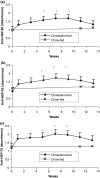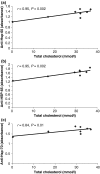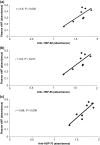Relationship between plasma cholesterol, von Willebrand factor concentrations, extent of atherosclerosis and antibody titres to heat shock proteins-60, -65 and -70 in cholesterol-fed rabbits
- PMID: 17696906
- PMCID: PMC2517311
- DOI: 10.1111/j.1365-2613.2007.00542.x
Relationship between plasma cholesterol, von Willebrand factor concentrations, extent of atherosclerosis and antibody titres to heat shock proteins-60, -65 and -70 in cholesterol-fed rabbits
Abstract
Epidemiological studies have shown an association between atherosclerosis, Heat shock protein (Hsp) expression, and Hsp antibody titres. We aimed to investigate the time course of appearance of Hsp-60, -65 and -70 antibodies in the cholesterol-fed rabbit and to relate antibody titres to serum concentrations of von Willebrand factor (vWF), a marker of endothelial injury. Rabbits were fed with 0.25-1.0% cholesterol diet for 13 weeks. Plasma levels of anti Hsp-60, -65 and -70 IgG titres, were measured using in-house enzyme-linked immunosorbent assays (ELISAs) together with plasma vWF concentrations. Plasma titres of anti-Hsp-60, -65 and -70 antibodies were all significantly increased by weeks 5, 7 and 9 following commencement of the experimental diet compared with baseline (P < 0.05 for all). In non-cholesterol-fed rabbits, plasma levels of anti-Hsp titres were unchanged over this period. Increased plasma vWF concentrations were also found in the cholesterol-fed rabbits, reaching a maximum at approximately week 8, and falling thereafter. Furthermore, plasma vWF concentrations at 13 weeks correlated strongly with antibody titres to all three Hsps (r = 0.90, P = 0.002; r = 0.80, P = 0.017; r = 0.86, P = 0.006 for Hsp 60, -65 and -70 respectively) and titres were also strongly correlated with final plasma cholesterol concentrations in cholesterol-fed animals (r = 0.95, P = 0.002; r = 0.8, P = 0.001; r = 0.84, P = 0.01 respectively). In cholesterol-fed rabbits, antibody titres to Hsp-60, -65 and -70 appear to rise in association with a marker of endothelial injury, peaking at approximately the same time (8 weeks) after starting a high cholesterol diet.
Figures




References
-
- Boneu B, Abbal M, Plante J, Bierme R. Factor VIII complex and endothelial damage. Lancet. 1975;1:1430. - PubMed
-
- Burian K, Kis Z, Virok D, et al. Independent and joint effects of antibodies to human heat-shock protein 60 and Chlamydia pneumoniae infection in the development of coronary atherosclerosis. Circulation. 2001;103:1503–1508. - PubMed
-
- Cucuianu MP, Cristea A, Roman S, Rus H, Missits I, Pechet L. Comparative behaviour of the components of the factor VIII complex in acute myocardial infarction. Thromb. Res. 1983;30:487–497. - PubMed
-
- De Meyer GRY, Hoylaerts MF, Kockx MM, Yamamoto H, Herman AG, Bult H. Intimal deposition of functional von Willebrand factor in atherogenesis. Arterioscler. Thromb. Vasc. Biol. 1999;19:2524–2534. - PubMed
-
- Ewenstein BM. In: Vascular biology of von Willebrand factor. In: Vascular Endothelium. Born GVR, Schwartz CJ, editors. Schattauer: Stuttgart; 1997. pp. 107–123.
Publication types
MeSH terms
Substances
LinkOut - more resources
Full Text Sources
Medical
Research Materials
Miscellaneous

